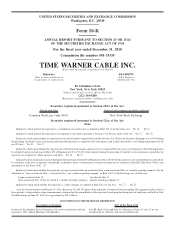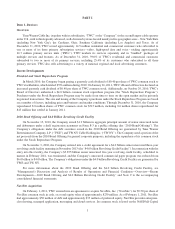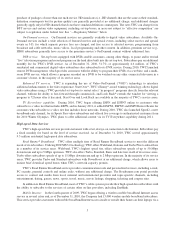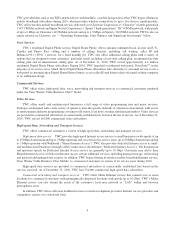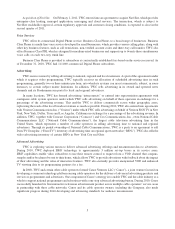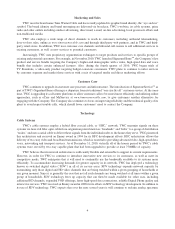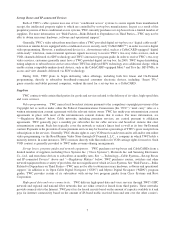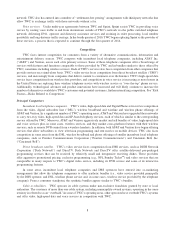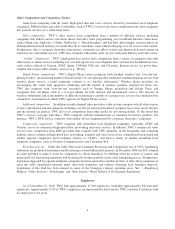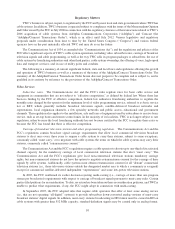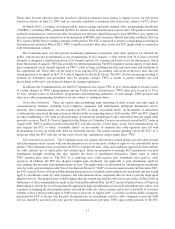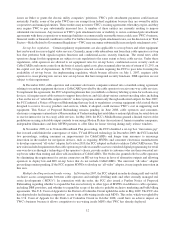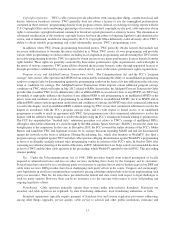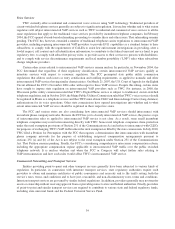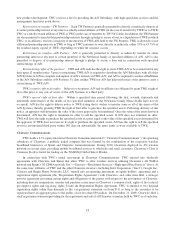Time Warner Cable 2010 Annual Report Download - page 21
Download and view the complete annual report
Please find page 21 of the 2010 Time Warner Cable annual report below. You can navigate through the pages in the report by either clicking on the pages listed below, or by using the keyword search tool below to find specific information within the annual report.Other Competition and Competitive Factors
Aside from competing with the video, high-speed data and voice services offered by incumbent local telephone
companies, DBS providers and cable overbuilders, each of TWC’s services also faces competition from other companies
that provide services on a stand-alone basis.
Video competition. TWC’s video service faces competition from a number of different sources, including
companies that deliver movies, television shows and other video programming over broadband Internet connections,
such as Hulu.com, Apple Inc.’s iTunes, Netflix Inc.’s “Watch Instantly” and YouTube. Increasingly, content owners are
utilizing Internet-based delivery of content directly to consumers, some without charging a fee for access to the content.
Furthermore, due to consumer electronics innovations, consumers are able to watch such Internet-delivered content on
television sets and mobile devices. TWC also competes with online order services with mail delivery and video stores.
“Online” competition. TWC’s high-speed data service faces competition from a variety of companies that offer
other forms of online services, including low cost dial-up services over telephone lines and wireless broadband services,
such as those offered by Verizon, AT&T, Sprint, T-Mobile USA, Inc. and Clearwire, Internet service via power lines,
satellite and various other wireless services (e.g., Wi-Fi).
Digital Phone competition. TWC’s Digital Phone service competes with wireline, wireless and “over-the-top”
phone providers. An increasing number of homes in the U.S. are replacing their traditional wireline telephone service with
wireless phone service, a trend commonly referred to as “wireless substitution.” Wireless phone providers are
encouraging this trend with aggressive marketing and the launch of wireless products targeted for home use.
TWC also competes with “over-the-top” providers, such as Vonage, Skype, magicJack and Google Voice, and
companies that sell phone cards at a cost per minute for both national and international service. The increase in
wireless substitution and in the number of different technologies capable of carrying voice services has intensified the
competitive environment in which TWC operates its Digital Phone service.
Additional competition. In addition to multi-channel video providers, cable systems compete with all other sources
of news, information and entertainment, including over-the-air television broadcast reception, live events, movie theaters
and the Internet. In general, TWC also faces competition from other media for advertising dollars. To the extent that
TWC’s services converge with theirs, TWC competes with the manufacturers of consumer electronics products. For
instance, TWC’s DVR service competes with similar devices manufactured by consumer electronics companies.
Commercial competition. TWC competes with incumbent local telephone companies, especially AT&T and
Verizon, across its commercial high-speed data, networking and voice services. In addition, TWC’s commercial video
service faces competition from DBS providers that compete with TWC primarily in the hospitality and restaurant
industry, and its commercial high-speed data, networking, transport and voice services face competition from national and
smaller regional competitive local exchange carriers, or “CLECs,” and from a variety of smaller incumbent local
telephone companies, such as Frontier Communications and Cincinnati Bell.
Franchise process. Under the Cable Television Consumer Protection and Competition Act of 1992, franchising
authorities are prohibited from unreasonably refusing to award additional franchises. In December 2006, the FCC adopted
an order intended to make it easier for competitors to obtain franchises, by defining when the actions of county- and
municipal-level franchising authorities will be deemed to be unreasonable as part of the franchising process. Furthermore,
legislation supported by regional telephone companies has been enacted in a number of states to allow these companies to
enter the video distribution business under state-wide franchises and without obtaining local franchise approval.
Legislation of this kind has been enacted in some of the Company’s largest operating areas. See “—Regulatory
Matters—Video Services—Franchising” and “Risk Factors—Risks Related to Government Regulation.”
Employees
As of December 31, 2010, TWC had approximately 47,500 employees, including approximately 940 part-time
employees. Approximately 4.3% of TWC’s employees are represented by labor unions. TWC considers its relations with
its employees to be good.
9


